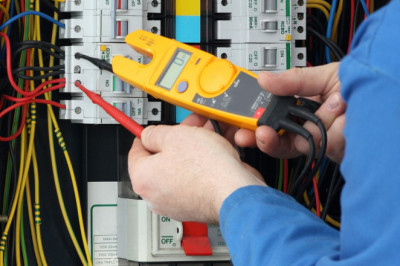views

Fiberglass Fabric Market size is forecast to reach $8.5 billion by 2025, after growing at a CAGR of 5.4% during 2020-2025, owing to the rising demand of fiberglass fabric from various end-use industries such as building & construction, automotive & transportation, wind energy, aerospace & defense, chemical, and more. The demand for fiberglass fabrics is increasing in varied industries due to their extensive set of characteristics such as high tensile strength, dimensional stability, high heat resistance, fire resistance, excellent thermal conductivity, good chemical resistance, and more. In addition, fiberglass fabrics are being extensively used in the electrical & electronics applications because of its lightweight, electrical, and durable properties, which is anticipated to boost the fiberglass fabric market during the forecast period.
By Fiberglass Type – Segment Analysis
The E-glass fiberglass segment held the largest share in the fiberglass fabric market in 2019, owing to its superior properties such as inorganic, good abrasion resistance, low thermal conductivity, excellent dielectric strength, and more. They are also characterized by their resistance to continuous high temperatures of up to 550°C and their excellent electrical insulation properties. E-glass fiber is rot-proof, can withstand the main chemical agents, and remains dimensionally stable, even under intense variations of humidity and temperature. In addition, E-glass fiber is much stronger than steel in tensile strength and almost as strong as industrial-grade carbon fiber. Thus, the extensive characteristics and cost efficiency of E-glass fiberglass are anticipated to boost the demand for E-glass fiberglass during the forecast period.
Request for Sample of the Report @ https://www.industryarc.com/pdfdownload.php?id=500326
Report Price: $ 4500 (Single User License)
By Fabric Type – Segment Analysis
The woven fabric segment held the largest share in the fiberglass fabric market in 2019, as they offer superior performance as compared to the nonwoven type. It is manufactured from chopped strand mats and can bring several structural advantages. The woven fabrics are superior to non-woven type due to its feature of interlocked layers that prevent delimitation, offers high impact resistance, and create a strong barrier. This extensive characteristic of woven fabric is anticipated to boost the demand for woven fabrics during the forecast period.
By End-Use Industry – Segment Analysis
The building and construction sector held the largest share in the fiberglass fabric market in 2019 and is growing at a CAGR of 6.56%, owing to the increasing demand of fiberglass fabrics as a raw material from the building and construction industries for construction applications such as the insulation panels, roof panels, façade, roof plates, and more. They are preferred in the construction area because of their properties to withstand longitudinal & transverse load, and chemical & corrosion resistance. They are used as a highly effective insulation material in exterior and roof panel applications due to their waterproof properties. Also, they are used in construction applications such as mesh fabrics, drywall tapes, wall coverings, flooring, and more as they are durable, naturally fire-resistant, and they do not elongate or shrink. Thus, with the increasing building and construction sector, the demand for fiberglass fabric will also increase, which will boost the fiberglass fabric market in the building and construction sector during the forecast period.
By Geography – Segment Analysis
Asia Pacific region held the largest share in the fiberglass fabric market in 2019 up to 31%, owing to the increasing building and construction industry in the APAC region. The building and construction activities are increasing in countries, such as India, China, and Singapore due to economic reforms and rising per capita income of the individuals. The population growth is resulting in the need for more residential and commercial sectors. In India, the government has initiated projects, such as ‘100 smart cities’ and ‘Housing for All by 2022,’ which are expected to drive the Indian residential construction market over the forecast period. According to the International Trade Administration (ITA), the construction value of China in 2018 was USD 893.58 and it is forecasted to reach USD 968.06 by 2019. Also, the Chinese construction industry is forecasted to grow at an annual average of 5% in real terms between 2019 and 2023. According to the Australian trade and investment commission, the government projected Singapore’s average construction demand for 2018 and 2019 between S$26 billion to S$35 billion. Such initiatives are leading to increased building and construction activities by the government in the region, which is further anticipated to drive the fiberglass fabric market in the Asia Pacific during the forecast period.
Drivers – Fiberglass Fabric Market
Increasing Aerospace Industry
Fiberglass is used in both military and civilian aerospace industry for manufacturing parts such as test equipment, ducting, enclosures, and others due to its superior tensile strength and compressive strength qualities. They are extensively used to reduce weight (up to 20% over aluminum), improve fuel economy, and increase the flying range of aerospace. According to the International Trade Administration (ITA), in 2019 China was the world’s second-largest civil aerospace and aviation services markets and one of the fastest-growing markets. In 2016, according to Boeing, China is estimated to require around 6,810 new commercial aircraft, valued at USD 1 trillion, over the next two decades. By the end of 2018, China had more than 59 airlines and 3,615 civil aircraft, an increase of 10% over 2017. According to China’s 13th Five Year Plan (2016-2020), by 2018, the number of Chinese civil airports had grown to 235. According to the International Trade Administration (ITA), in 2018 the Indian government spent a total of $645 in the civil aviation sector. Also, according to Boeing India is expected to drive the demand for 2,300 aircrafts worth US$320 billion over the next 20 years. Thus, with increasing aerospace industry the demand for fiberglass fabric will also increase, which acts as a driver for the fiberglass fabric market.
Increasing Automotive Production
In the modern world, there are many vehicle parts currently being made of fiberglass fabric, where weighing is crucial. Fiberglass is mainly used in the front and rear bumpers, hoods, doors, casings, timing belts, and V-belts, due to the high tensile strength, temperature resistance, and dimensional stability of the fiberglass fabric. According to the International Trade Administration (ITA), China is the world’s largest vehicle market and the Chinese government is expecting that automobile production will reach 35 million by 2025. According to the China Association of Automobile Manufacturers, in 2018 over 27 million vehicles were sold. In 2017, according to the International Trade Administration (ITA), 1.2 million new passenger cars, SUVs, and commercial vehicles were sold in the Australian market, an increase of 0.9% from 2016. Also, according to OICA, the production of light commercial vehicles has increased by 10.2 % in 2018 in the APAC region. Also, automotive parts such as clutch discs and brake pads are reinforced with woven fiberglass fabrics to maintain the integrity of the composite in a hot and abrasive environment. Thus, the increasing automation production will require more fiberglass fabric for manufacturing various automotive parts, which will act as a driver for the fiberglass fabric market during the forecast period.
Talk to one of our sales representative about the full report by providing your details in the link below:
https://www.industryarc.com/support.php?id=500326
Challenges – Fiberglass Fabric Market
High Production Cost of Fiberglass Fabric
The product is highly capital-intensive with the high cost of the furnace and other machinery. Furthermore, manufacturing methods such as Vacuum Assisted Transfer Molding (VARTM) and autoclaving are both time consuming and labor-intensive. The fiber production process is time-consuming and complicated. More importantly, it requires a tremendous amount of energy. The energy costs alone make up a good portion of the total cost of fiber production. In terms of labor, it is practically expensive given that composite manufacturing is a highly specialized field. The same is true for machining. The more advanced the products, the more expensive the labor and machining costs. Thus, handling of raw material and final product requires skilled labor, thereby increasing the cost of production.
Covid-19 Impact on The Fiberglass Fabric Market
Due to the Covid-19 outbreak, all the building and construction activities are stopped until the pandemic, and no new orders can be taken over neither the existing order production could be completed, which is heavily affecting the fiberglass fabric market. In addition, COVID-19 pandemic is having a huge impact on the aviation industry. The production of aircraft has been disruptively stopped, contributing to a major loss in the total aerospace sectors. According to the Welsh Government services and information, global demand for production of short-haul sized aircraft is likely to drop by 15% (around 1,500 fewer aircraft out of 10,000) and by 30 - 65% for long haul sized craft, by the end of 2025, (around 600 - 1,300 fewer aircraft out of 2,000).
Market Landscape
Technology launches, acquisitions, and R&D activities are key strategies adopted by players in the fiberglass fabric market. In 2019, the market of fiberglass fabric has been consolidated by the top five players accounting for xx% of the share. Major players in the fiberglass fabric market are Owens Corning, Gurit, Jushi Group Co., Ltd., Chomarat Textile Industries, Saertex GmbH & Co.KG., Tah Tong Textile Co. Ltd, Auburn Manufacturing Inc., BGF Industries Inc., Nitto Boseki Co. Ltd., and Taiwan Electric Insulator Co. Ltd.
Acquisitions/Technology Launches
In January 2016, Owens Corning acquired the glass non-wovens and fabrics businesses of Ahlstrom, to strengthen its position as a global leader in the non-wovens and wind energy, high-modulus glass, and specialty fabrics segments.
In June 2018, Owens Corning entered into a strategic cooperation and supply agreement with Chongqing Polycomp International Corp. (CPIC) for joint investment in technology, and construction and operation by CPIC of a new facility dedicated to the manufacture of high-modulus glass fiber products in China.
In December 2018, Jushi India Fiberglass, part of China’s Jushi Group, set up a fiberglass manufacturing plant in Maharashtra at an investment of $246 million.
In April 2019, Nitto Boseki Co. acquired Taiwan's Baotek Industrial Materials Ltd. to strengthen its glass fiber supply chain amid growing demand from the electronics sector.
Key Takeaways
Asia Pacific dominates the fiberglass fabric market, owing to increased manufacturing & construction activities due to various government initiatives in the region such as 100 smart cities and Housing for all by 2022.
The fiberglass fabrics are used in lightweight constructions of the globally growing wind energy industry, where they have been integrated into multiple wind energy applications such as composite manufacturing of rotor blades and nacelles for wind generation.
The fiberglass fabrics are resistant to aggressive chemicals, liquids, and alkalis. This makes them ideal for applications such as wastewater treatment plants, swimming pools, cooling towers, and construction, where there is a risk of corrosion.
Fiberglass and hemp, in the form of fabrics, are extensively used to reinforce the thermosetting polymers matrix, which includes a traditional epoxy resin or polyester resin and a linseed oil-based bio-resin (UVL).
Due to the COVID-19 Pandemic, most of the countries have gone under lockdown, due to which operations of various industries such as automotive and aerospace have been negatively affected, which is hampering the fiberglass fabric market growth.
Related Reports :
A. Performance Fabric Market
https://www.industryarc.com/Report/15982/performance-fabric-market.html
B. Polymer Coated Fabrics Market
https://www.industryarc.com/Report/16420/polymer-coated-fabrics-market.html
About IndustryARC:IndustryARC primarily focuses on Cutting Edge Technologies and Newer Applications market research. Our Custom Research Services are designed to provide insights on the constant flux in the global supply-demand gap of markets. Our strong team of analysts enables us to meet the client research needs at a rapid speed, with a variety of options for your business. Any other custom requirements can be discussed with our team, drop an e-mail to sales@industryarc.com to discuss more about our consulting services.












